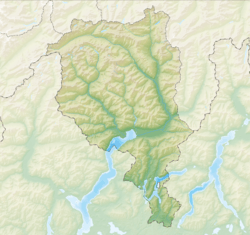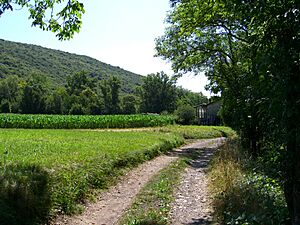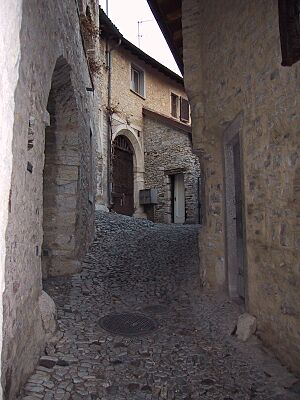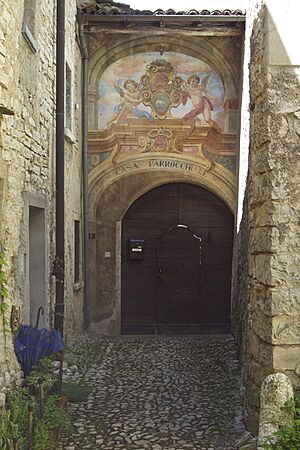Meride facts for kids
Quick facts for kids
Meride
|
||
|---|---|---|
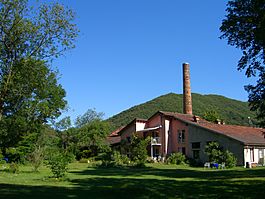
Camino Spinirolo near Meride village
|
||
|
||
| Country | Switzerland | |
| Canton | Ticino | |
| District | Mendrisio | |
| Area | ||
| • Total | 7.46 km2 (2.88 sq mi) | |
| Elevation | 583 m (1,913 ft) | |
| Population
(Dec 2011)
|
||
| • Total | 314 | |
| • Density | 42.09/km2 (109.02/sq mi) | |
| Postal code |
6866
|
|
| Surrounded by | Arzo, Besano (IT-VA), Brusino Arsizio, Porto Ceresio (IT-VA), Riva San Vitale, Saltrio (IT-VA), Tremona, Viggiù (IT-VA) | |
Meride is a charming village in Switzerland, located in the Ticino canton. It used to be its own municipality. However, on April 14, 2013, Meride joined with two other villages, Besazio and Ligornetto. They all became part of the larger Mendrisio municipality.
Contents
Discovering Meride's Past
Meride has a long and interesting history. It was first mentioned way back in 852. At that time, it was known as Melede. Later, in 1430, its name changed slightly to Merede.
Fossils and Ancient Life
The land around Meride is very special for scientists. Geologists and paleontologists love to explore here. This is because of a unique rock formation called Meridekalk. It's made of chalk from the Triassic period. Many new fossils have been found during excavations at Monte San Giorgio. These discoveries help us learn about ancient life.
Village Development and Churches
In 963, a powerful abbey in Milan gave its land in Meride to a monastery in Lodi. During the Middle Ages, Meride was part of a larger area called the Pieve of Riva San Vitale. Meride, along with Besazio and Tremona, formed a "Terzi." This meant they shared rights to use the local fields and forests.
Meride became an independent parish in 1483. This meant it had its own church and priest. The old parish church of San Silvestro was built that same year. It stands on a hill, possibly on the remains of an old castle. The current parish church, San Rocco, was built in 1578. It was made bigger in the 1770s and restored in the late 1960s. A hermitage was also built nearby by Manfredo Settala. Next to it, the 13th-century chapel of Saint George was built.
Life and Work in Meride
In the past, most people in Meride worked in farming. They also raised animals. In the 20th century, the number of people living in Meride slowly went down. But in the 1990s, new homes helped the population stay steady. By 2000, most working people traveled to other towns for their jobs. In 1973, a fossil museum opened in Meride. More recently, tourism has become important, especially in the summer.
Meride's Location and Landscape
Meride covers an area of about 7.5 km2 (2.9 sq mi). A small part, about 9.9%, is used for farming. Most of the land, about 88.6%, is covered by forests. The rest is made up of buildings, roads, or unproductive land.
The village is located in the Mendrisio district. It stretches from the top of San Giorgio mountain down to its lower slopes. The village center sits on these lower slopes.
Meride's Coat of Arms
The coat of arms for Meride is quite colorful. It is divided into four sections, alternating red and silver. In the top two sections, there's an eight-pointed star. Across the middle, there's a golden band. On this band, you can see a blue gate with two towers.
People of Meride
In 2011, Meride had a population of 314 people. About 5.7% of the people living there in 2008 were from other countries. Over ten years, from 1997 to 2007, the population grew by about 1.9%.
Languages Spoken
Most people in Meride speak Italian, about 84.6% of the population. German is the second most common language, spoken by about 11.6%. A small number of people, 1.4%, speak French.
Population Changes
In 2008, there were slightly more women (52.6%) than men (47.4%) living in Meride. That year, the number of Swiss citizens in Meride went down slightly. However, the total population of the village increased by 1.5% due to people moving in.
Age Groups
Looking at the age groups in 2009:
- About 6% of the population were children aged 0-9.
- About 9.4% were teenagers aged 10-19.
- Adults aged 20-59 made up about 51.1% of the population.
- Seniors aged 60 and over made up about 33.6% of the population.
Homes in Meride
In 2000, there were 137 homes in Meride. On average, about 2.1 people lived in each home. Most of the buildings, about 70.5%, were single-family homes. Many of these homes were built between 1919 and 1945.
The historical population of Meride has changed over time:

Important Heritage Sites
The Church of S. Silvestro is a very important building in Switzerland. It is listed as a heritage site of national significance. This means it's a special place that needs to be protected. The entire village of Meride is also recognized as an important heritage site.
Meride's Economy and Jobs
In 2007, the unemployment rate in Meride was low, at 2.86%. Most jobs in Meride are in the service industry. This includes things like hotels, restaurants, and information services.
Working Life
In 2008, there were 39 full-time jobs in Meride.
- 9 jobs were in farming.
- 2 jobs were in construction.
- 28 jobs were in the service industry. This included jobs in sales, transportation, hotels, and education.
Many people who live in Meride travel to other towns for work. In 2000, 95 people left Meride to work elsewhere. Only 26 people came into Meride for work. Most people used a private car to get to work. In 2009, Meride had one hotel, which helps with tourism.
Religion in Meride
According to the 2000 census, most people in Meride are Roman Catholic, about 74.7%. About 7.2% belonged to the Swiss Reformed Church. A small number of people belonged to other churches or did not state their religion.
Education in Meride
Meride has a good education system. About 79.9% of adults (aged 25–64) have finished high school or gone on to higher education.
Student Life
In 2009, there were 51 students in Meride.
- 6 children were in kindergarten.
- 11 students attended standard primary schools.
- 2 students attended special primary schools.
- 15 students were in middle school.
- 9 students were in a program to prepare for higher education.
For older students, there are different paths. Some students go to vocational schools to learn a trade. In 2009, 4 students were full-time vocational students, and 3 were part-time. One student was in a professional program, preparing for jobs like engineering or nursing. In 2000, 43 students from Meride went to schools outside the village.
See also
 In Spanish: Meride para niños
In Spanish: Meride para niños




